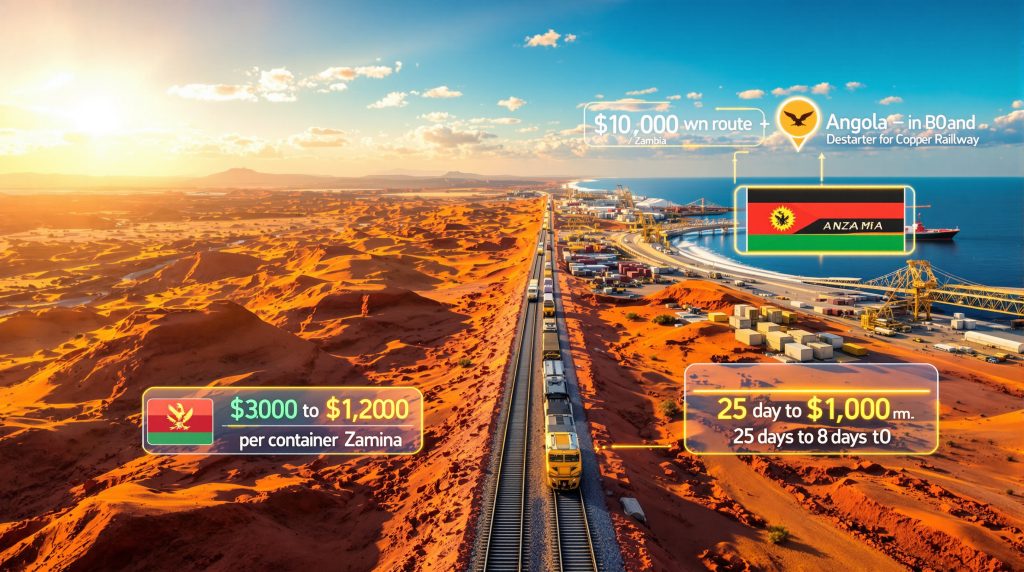The Angola rail link copperbelt project represents one of Africa's most ambitious infrastructure developments, with the potential to transform regional mining logistics and global copper supply chains. This $4.5 billion railway initiative connecting Zambia's mineral-rich Copperbelt to Angola's Atlantic coast offers unprecedented opportunities for enhanced copper price insights and market positioning.
Understanding the Strategic Importance of the Angola Rail Link Copperbelt Connection
The Angola rail link copperbelt initiative addresses critical bottlenecks that have constrained mineral exports from landlocked regions for decades. Currently, copper shipments from Zambia's mining heartland face 25-day road transport journeys to reach South African ports, creating substantial cost burdens and supply chain vulnerabilities for mining operations.
The Zambian Copperbelt, encompassing major mining centers in Chingola, Kitwe, and surrounding regions, contributes approximately 750,000 tonnes of refined copper annually according to recent Zambian Ministry of Mines data. When combined with neighboring Democratic Republic of Congo production, the region accounts for nearly 4% of global copper output, making efficient export infrastructure essential for meeting international demand.
Transport cost analysis reveals the economic significance of the proposed rail connection. Current road-based logistics to Durban port cost approximately $3,000 per container, while rail transport via the Angola rail link copperbelt route projects costs of $1,200 per container – representing a 60% reduction in transportation expenses for mining companies.
Economic Impact on Regional Mining Operations
Industry analysts project the improved logistics could enable 15-20% increases in regional copper production capacity by reducing operational constraints that currently limit mine expansion. The 8-day rail journey to Lobito port compares favorably against existing alternatives, offering mining companies enhanced flexibility for export timing and inventory management.
Mining operations throughout the Copperbelt region have historically faced infrastructure limitations that prevent full utilization of proven reserves. Furthermore, the railway could unlock stranded assets by making previously marginal deposits economically viable through reduced transport costs, particularly when considering South African beneficiation strategies.
Key operational improvements include:
- Reduced inventory holding periods at mine sites
- Enhanced scheduling flexibility for production planning
- Lower working capital requirements for logistics operations
- Improved access to Atlantic shipping markets
The railway's 50 million tonnes annual capacity target by 2030 would accommodate substantial growth in mineral exports beyond current production levels, positioning the corridor as a long-term catalyst for regional mining development.
International Funding Architecture and Financial Commitments
The Angola rail link copperbelt project has secured $1.37 billion in confirmed funding commitments, representing approximately 30% of the total $4.5 billion requirement. This financing structure involves multiple international development organizations and strategic government partnerships.
Italy's $320 million commitment reflects European Union interests in diversifying critical mineral supply chains. The funding aligns with broader EU strategies to reduce dependence on single-source mineral imports and strengthen partnerships with resource-rich African nations.
The African Development Bank's $500 million allocation supports the institution's regional integration objectives and infrastructure connectivity mandates. In addition, ADB financing typically involves concessional lending terms designed to facilitate cross-border development projects with broader economic multiplier effects.
United States Strategic Investment Framework
The US International Development Finance Corporation approved a $553 million loan in June 2024, though disbursement remains pending as of late 2025. This commitment originated under the Biden administration's Africa strategy, which prioritized critical minerals security and supply chain diversification initiatives.
According to Bloomberg's recent reporting, Angola continues to actively seek additional funding for this ambitious infrastructure project. However, as of October 2025, the Trump administration has not publicly confirmed continuation of this DFC commitment, creating potential uncertainty around US financial participation.
Egypt's recent expression of interest in project financing adds another dimension to the international funding landscape, though specific financial commitments have not been disclosed. Egyptian participation could reflect broader African continental integration objectives and potential trade corridor development between Atlantic and Mediterranean markets.
| Funding Source | Amount (Million USD) | Status | Terms |
|---|---|---|---|
| Italy | $320 | Committed | Government partnership |
| African Development Bank | $500 | Committed | Concessional lending |
| US Development Finance Corp | $553 | Approved, pending disbursement | Project financing |
| Egypt | Undisclosed | Interest expressed | Under discussion |
| European Union | Undisclosed | Interest indicated | Evaluation phase |
The $3.1 billion funding gap requires additional international partnerships or private sector participation to achieve full project capitalisation. Africa Finance Corporation, which holds the concession oversight rights, plans to launch competitive tending processes in 2025 to attract construction and financing partnerships.
Atlantic vs Indian Ocean Export Route Analysis
The Angola rail link copperbelt creates a westward export alternative to traditional southern and eastern African shipping routes. Current copper exports from the Copperbelt region primarily utilise Durban (South Africa) and Dar es Salaam (Tanzania) ports, both accessing Indian Ocean shipping networks.
Lobito port offers several strategic advantages for copper exporters targeting North American and European markets. Atlantic shipping routes reduce total transit times to consuming regions by 5-8 days compared to Indian Ocean alternatives, enhancing supply chain responsiveness and reducing inventory financing costs.
Competitive Route Comparison
| Export Route | Rail Distance | Transit Time | Primary Markets | Capacity Constraints |
|---|---|---|---|---|
| Lobito Corridor | 1,739 km | 8 days | North America, Europe | Limited current capacity |
| Dar es Salaam | 1,860 km | 14 days | Asia, Europe | Moderate congestion |
| Durban | 2,400 km | 25 days | Global markets | High utilisation |
The Tanzania-Zambia Railway (TAZARA), constructed by China in the 1970s, provides historical context for alternative export infrastructure. However, TAZARA has experienced capacity limitations and operational challenges, highlighting the importance of modern engineering standards and comprehensive maintenance programs for the Angola rail link copperbelt project.
Port capacity analysis reveals potential constraints at destination facilities. Consequently, Lobito port currently handles approximately 500,000 TEU annually, requiring substantial expansion to accommodate projected mineral export volumes. Port modernisation investments concurrent with railway construction will be essential for realising full corridor benefits.
Supply chain resilience considerations favour route diversification strategies. Mining companies increasingly recognise the risks of single-corridor dependency, particularly given periodic congestion at major ports during peak shipping seasons or infrastructure maintenance periods.
Technical Specifications and Engineering Requirements
The Angola rail link copperbelt employs standard gauge specifications (1,435mm), ensuring compatibility with international railway systems and existing Angolan infrastructure. This engineering decision facilitates interoperability with the rehabilitated Benguela Railway, which has operated successfully since 2014 following post-conflict reconstruction.
Major engineering challenges include Zambezi River crossings and associated tributary bridges capable of supporting heavy mineral freight loads. Bridge design specifications must accommodate 25-tonne axle loads typical of modern mining railway operations while maintaining structural integrity across varying seasonal water levels.
Construction Timeline and Implementation Phases
2025-2026: Environmental assessments completion and construction contractor selection through Africa Finance Corporation's competitive tendering process.
2026-2028: Primary construction phase including:
- Railway bed preparation and grading
- Bridge construction across major waterways
- Border crossing facility development
- Signal and communication system installation
2028-2030: Testing, commissioning, and operational ramp-up targeting 50 million tonnes annual capacity by full implementation.
Cross-border infrastructure requirements encompass customs facilities, security systems, and regulatory harmonisation between Angolan and Zambian authorities. Successful implementation requires coordination of different national railway operational standards and maintenance protocols.
The project's integration with existing Benguela Railway infrastructure provides operational advantages through established maintenance capabilities and experienced personnel. However, capacity expansion at connection points may require additional investment to prevent bottlenecks at system interfaces.
Mining Companies Positioned for Enhanced Logistics Access
The Angola rail link copperbelt project directly benefits major copper producers operating throughout the Zambian Copperbelt and southern Democratic Republic of Congo mining regions. Ivanhoe Mines and Trafigura have been identified as initial corridor users, indicating established commercial relationships with corridor operators.
Zambian mining operations in Chingola, Kitwe, and surrounding areas collectively produce over 750,000 tonnes of refined copper annually. These facilities include both large-scale integrated operations and smaller specialty producers focused on high-grade concentrate production.
Operational Cost Impact Analysis
Mining companies project 12-18% reductions in total operating costs through improved logistics efficiency. These savings result from multiple factors:
- Reduced transport costs per tonne of output
- Lower inventory carrying costs through faster port access
- Enhanced production scheduling flexibility
- Reduced equipment wear from road transport elimination
Kolwezi-based operations in the Democratic Republic of Congo represent another significant beneficiary category. The region's cobalt and copper mining complex could utilise the corridor for diversified export routing, reducing dependence on traditional eastern routes through Tanzania.
Smaller-scale mining operations throughout the Copperbelt region may experience the most significant relative benefits from the project. Transport cost reductions could make previously marginal deposits economically viable, particularly when considering emerging Zambian copper investment opportunities in the region.
Industry analysis suggests the improved infrastructure could enable 15-20% increases in regional copper production capacity over five years through:
- Expansion of existing mining operations
- Development of previously stranded mineral assets
- Enhanced feasibility for new mining projects
- Improved access to international capital for mine development
Global Copper Market Implications and Price Dynamics
The Angola rail link copperbelt project emerges during a period of exceptional copper market strength, with prices reaching $5.10 per pound as of late 2025. This pricing environment enhances project economics and provides strong incentives for rapid implementation.
Enhanced supply chain efficiency from the Copperbelt region could influence global copper market dynamics through improved supply reliability and reduced transportation bottlenecks. Furthermore, understanding copper demand trends suggests the corridor's impact on international pricing will depend on broader supply-demand fundamentals and competing production growth from other regions.
Strategic Minerals Security and Geopolitical Considerations
The project represents Western nations' efforts to diversify critical mineral supply chains away from routes controlled or influenced by competing geopolitical powers. The Atlantic-focused corridor provides alternative access to Copperbelt production for North American and European consumers.
Copper supply chain resilience benefits from route diversification strategies that reduce single-point failure risks. Consequently, the Angola rail link copperbelt creates redundancy in export infrastructure, potentially stabilising global copper supply availability during regional disruptions affecting other corridors.
Market analysts project the corridor could handle 8-10% of total African copper exports by 2030, representing meaningful diversification for international buyers seeking supply security. This market share would position the Lobito Corridor as a significant factor in global copper trade flows.
Long-term copper demand projections, driven by renewable energy infrastructure and electric vehicle adoption, support substantial infrastructure investments in mining logistics. The International Energy Agency forecasts doubling of copper demand by 2040, creating strong economic justification for enhanced export capacity from major producing regions.
Environmental Compliance and Community Development Impacts
The Angola rail link copperbelt project requires comprehensive environmental impact assessments addressing cross-border ecological considerations. Key environmental challenges include wildlife corridor preservation, water resource management, and habitat fragmentation mitigation strategies.
Wildlife conservation measures must account for seasonal migration patterns across the railway route, particularly in areas intersecting with protected ecosystems. Engineering solutions include wildlife crossing structures and acoustic barriers to minimise ecological disruption.
Social and Economic Development Benefits
Construction phase employment projections indicate 15,000+ temporary jobs during peak building periods, with 3,000+ permanent positions for ongoing railway operations and maintenance. Local workforce development programmes aim to maximise community participation in construction activities.
Regional economic multiplier effects extend beyond direct mining benefits:
- Enhanced agricultural export capabilities through shared rail infrastructure
- Improved access to international markets for small-scale producers
- Development of service industries supporting corridor operations
- Increased government revenues through transit fees and taxation
Skills development initiatives accompanying the project include technical training programmes for railway operations, maintenance, and border management. These educational investments create lasting human capital benefits for participating communities.
Community displacement considerations require careful planning and adequate compensation mechanisms. The railway route traverses populated areas where land acquisition and resettlement may be necessary, demanding transparent consultation processes and fair compensation protocols.
Long-term Expansion Prospects and Regional Integration
The Angola rail link copperbelt represents the initial phase of broader trans-African railway network development initiatives. Future expansion possibilities include connections to additional mineral-rich regions throughout central Africa, creating comprehensive continental trade corridors.
Integration with agricultural export capabilities could diversify corridor utilisation beyond mining applications. Zambia's agricultural sector, including maize, soybeans, and tobacco production, could benefit from improved access to international markets through the Atlantic corridor.
Performance Metrics and Financial Sustainability
Success metrics for the Angola rail link copperbelt project include:
- Target freight volumes: 50 million tonnes annually by 2035
- Revenue sustainability: Break-even operations within 8-10 years
- Regional trade growth: 25% increase in cross-border commerce
- Infrastructure utilisation: 75% capacity utilisation within 5 years of completion
Financial sustainability analysis depends on achieving sufficient cargo volumes to cover operational costs and debt service requirements. Diversified freight categories beyond copper mining will be essential for long-term economic viability.
The railway's strategic importance extends beyond immediate commercial returns, representing a foundation for broader regional economic integration. Success could catalyse additional infrastructure investments throughout southern and central Africa, creating lasting developmental benefits for participating nations.
Investment Perspective: The Angola rail link copperbelt project embodies more than infrastructure development – it represents a fundamental realignment of African mineral exports toward Atlantic markets, with potential to reshape global copper supply chain dynamics for decades while providing substantial regional economic development benefits.
Disclaimer: This analysis includes projections and estimates based on publicly available information. Actual project outcomes may vary due to construction challenges, market conditions, and regulatory changes. Investors should conduct independent research before making investment decisions related to mining infrastructure projects.
Ready to Capitalise on Africa's Mining Infrastructure Revolution?
The Angola rail link copperbelt project exemplifies the transformative infrastructure developments reshaping global mineral supply chains, creating substantial opportunities for astute investors. Discovery Alert's proprietary Discovery IQ model delivers real-time alerts on significant ASX mineral discoveries, empowering subscribers to identify actionable opportunities in mining logistics and copper investments ahead of the broader market and begin your 30-day free trial today to secure your competitive advantage.




